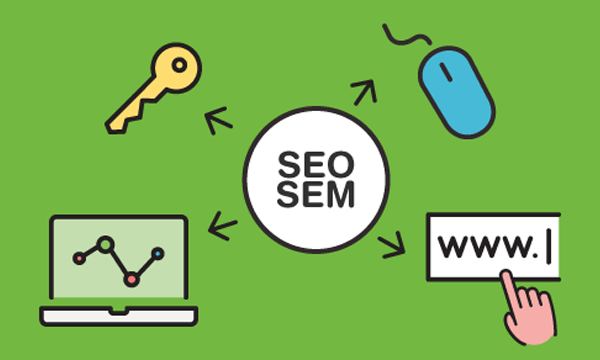Integrate SEO and SEM to improve content positioning

In this blog post, we give you an overview to understand the benefits of an integrated SEO and SEM strategy.

From developing integrations to strategic support, from creating creative concepts to optimizing results.
SEO and SEM: contact points
SEO (search engine optimisation) aims to achieve the best detection, analysis and reading of web content by search engines, in order to improve or maintain good positioning.
Whereas, SEM (search engine marketing) includes all activities aimed at driving qualified traffic to a certain website or specific content, through one or more keywords. To enliven the creation of AdWords campaigns, SEM could be described as the bell jar that holds SEA (search engine advertising), SMO (social media optimisation) and SEO.
The search engine is the first point of contact and common ground between SEO and SEM. The two activities focus their strategies on the same goal: to give visibility to digital content in the SERP (search engine results page).
Keywords are real centres of gravity that push browsers and online content towards each other. For both SEM and SEM activities, finding relevant and consistent keywords is paramount for optimising creativity and investment.
Both SEO and SEM require careful planning, with a well thought out editorial plan with set dates and sequences of publications, allowing brands to plan the work and give users an overview. The editorial plan creates a narrative, punctuated by episodes, and is able to develop a dialogue with its audience.
SEO and SEM, to give content credibility and visibility
Immediate and long-range benefits of positioning. This is the goal of integrating SEO and SEM, a double boost to unlock each of their potential and results.
On one hand, credibility and reliability of content in the eyes of search engines, and exposure just before publication on the other. SEO activities are oriented towards the long term, while SEM activities focus on the short term by investing resources in the immediate future.
Content optimisation on search engines is a long process, with variables that can make it necessary to redo what you’ve already done. Google’s changes in approach are the best examples of how this work can be subject to change and shifts in perspective. The latest opportunity came with the Mountain View giant’s shift from a quantitative approach to a qualitative one when analysing a web page: as a result, optimisation previously carried out on a piece of content proved counterproductive and some keywords lost their relevance. What was the result? A meltdown in search results.
Having the rug pulled out from underneath them, the brand had to (re)optimise a massive amount of content relating to each facet of online communication: webpages, blog posts or the brochure of an e-commerce.
One eye has to be on search engines, and the other on the audience. This is the task of SEO, aimed at enhancing all online content, whether it’s in progress, scheduled or assigned as the next step in the editorial calendar.
While SEO aims at achieving credibility in the eyes of search engines, SEM seeks to give maximum exposure just before the publication, driving and renewing traffic to the pages of a brand. This is the crossroads between SEO and SEM: creating a preferential channel to transport user traffic which is accessible and immediately available.
This is why an integrated SEO and SEM strategy is the cornerstone of digital marketing: to get results, you need to be both credible and popular at the same time.
